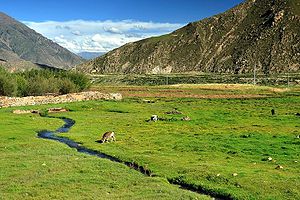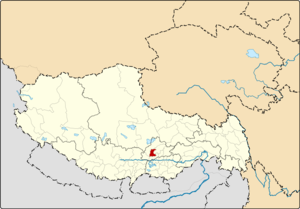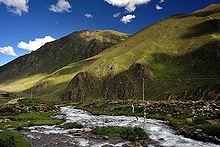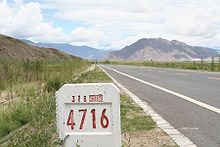- Doilungdêqên County
-
Doilungdêqên County — County — Tibetan transcription(s) – Tibetan སྟོད་ལུང་བདེ་ཆེན་རྫོང༌། – Wylie transliteration stod-lung-bde-chen rdzong – pronunciation in IPA – official transcription (PRC) Dölungdêqên Zong – THDL – other transcriptions Chinese transcription(s) – Traditional 堆龙德庆县 – Simplified – Pinyin Duīlóngdéqìng Xiàn Location of Doilungdêqên County within Tibet Coordinates: 30°0′56″N 90°50′30″E / 30.01556°N 90.84167°E Country China Province Tibet Prefecture Lhasa Prefecture Capital [[]] Area – Total 2,682 km2 (1,035.5 sq mi) Time zone China Standard (UTC+8) Doilungdêqên (Tibetan: སྟོད་ལུང་བདེ་ཆེན་རྫོང༌།, Wylie: stod-lung-bde-chen rdzong, ZYPY: Dölungdêqên Zong; simplified Chinese: 堆龙德庆县; pinyin: Duīlóngdéqìng Xiàn) is a county north-west of the main centre of Lhasa, Tibet. Tsurphu Monastery and Nenang Nunnery are located in the county.[1]
Contents
Geography
Doilungdêgên County is located in central and southern Tibet and is a suburb of Lhasa. It covers an area of 2682 square kilometers, with 9.6 million mu of cultivated land.[1] It has jurisdiction over 11 townships, one town, and 89 village committees.[1] Doilungdêqên Town has a notable missile base and is located just 11 or 12 kilometres from Lhasa. Other towns include Donggar and Ryugo. The county was established in under the Lhasa Municipal People's Government. The Yarlung Tsangpo river (Brahmaputra) flows through the county from west to east. The maximum altitude is 5,500 meters, with the lowest elevation at 3640 meters.[1] The valley to the southeast of the county is flat and open and is a temperate semi-arid monsoon plateau area. Precipitation during the rainy season is concentrated with intense solar radiation but a low temperature. Annual sunshine is about 3,000 hours, with an annual frost-free period of 120 days.[1] Annual precipitation is 440 millimeters on average and natural disasters, droughts, hail, frost, snow, pests, floods and so on are common.[1]
Economy
The main mineral resources are coal, iron, clay, lead, zinc and so on. Wildlife resources are: river deer, otters, brown bears, leopards, black-necked crane, Tibetan Eared Pheasant, Chinese caterpillar fungus, Fritillaria, snow lotus etc.[1]
Doilungdêgên County is based on agriculture. It is rich in wheat, spring wheat, barley, peas, beans, potatoes and so on. In 2004, 5.22 million mu of grain was sown.[1] Livestock is also important with cows, sheep, goats, poultry and so on.
Transport
References
External links
-
Lhünzhub · Damxung · Nyêmo · Qüxü · Doilungdêqên · Dagzê · Maizhokunggar · Chengguan District

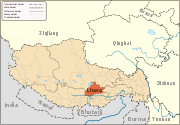
Towns and villages Monasteries
and palacesArchitecture of Lhasa · Lingkhor · Potala Palace · Norbulingka · Jokhang Temple · Tsomon Ling · Ganden Monastery · · Kundeling Monastery · Nechung · Nyethang Drolma Lhakhang Temple · Yangpachen Monastery · · Drepung Monastery · Ramoche Temple · Reting Monastery · Sanga Monastery · Yerpa
Sera Monastery: · Chupzang Nunnery · Drakri Hermitage · Garu Nunnery · Jokpo Hermitage · Keutsang Hermitage · Keutsang East Hermitage · Keutsang West Hermitage · Khardo Hermitage · Negodong Nunnery · Nenang Nunnery · Pabongkha Hermitage · Panglung Hermitage · Purbuchok Hermitage · Rakhadrak Hermitage · Sera Chöding Hermitage · Sera Gönpasar Hermitage · Sera Utsé Hermitage · Takten Hermitage · Trashi Chöling HermitageOther landmarks Banak Shöl Hotel · Barkhor · Chokpori · Drapchi Prison · Lhasa Brewery · Lhasa Hotel · Lhasa Zhol Pillar · Tibet Museum · Tibet University · Tromzikhang · Nyang bran · Hutoushan ReservoirTransport Lhasa Airport · Damxung Railway Station · Lhasa Railway Station · Lhasa West Railway Station · Wumatang railway station · Yangbajain Railway Station · G109 · G318 · North Linkor RoadGovernment Doje Cezhug · Jigme Namgyal
Coordinates: 30°00′56″N 90°50′30″E / 30.01556°N 90.84167°E
Categories:- Counties of Tibet
- Lhasa Prefecture
-
Wikimedia Foundation. 2010.

